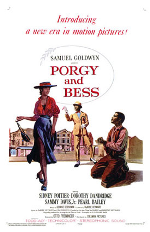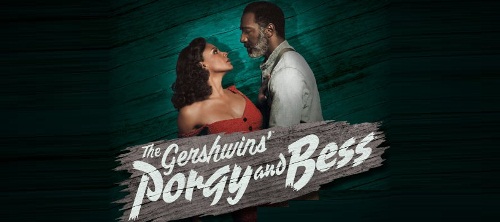
il aura fallu attendre les années 1980 pour que Porgy and Bess soit reconnu aux États-Unis comme un véritable opéra. Au XXIe siècle, c'est un classique du répertoire lyrique américain. Musicalement, Porgy and Bess réussit une synthèse innovante entre les techniques orchestrales européennes, le jazz américain et la musique populaire.
Acte I
Scène 1 - Catfish Row, un soir d'été
L'opéra commence par une petite introduction très vivace (Allegro con brio). Le rideau s'ouvre sur un soir d'été à Catfish Row. Jabso Brown joue du piano et Clara chante une berceuse pour son enfant (Summertime) pendant que les hommes se préparent à jouer au craps. Le mari de Clara, Jake, tente lui aussi de chanter une berceuse (A woman is a sometime thing), qui n'apaise guère le bébé. Porgy, un mendiant estropié, arrive pour organiser le jeu. Crown, un voyou, et sa femme Bess entrent, et le jeu commence. Sportin' Life, fournisseur de cocaïne et d'alcool de contrebande, prend lui aussi part au jeu. Petit à petit les joueurs quittent le jeu, et il ne reste plus que Robbins et Crown. Lorsque Robbins gagne, Crown, qui est maintenant complètement ivre, commence à se battre, et finit par tuer Robbins. Crown s'enfuit, demandant à Bess de se débrouiller toute seule. Tout le monde l'abandonne, sauf Porgy, qui la protège.Scène 2 - Chambre de Serena, la nuit suivante
La famille et les amis de Robbins chantent un spiritual (Where is brudder Robbins?). Une soucoupe est posée sur sa poitrine pour récolter de l'argent pour son enterrement. Un détective blanc entre, et dit à Serena, la femme de Robbins, qu'elle doit enterrer son mari rapidement, si elle veut éviter que le corps soit donné à des étudiants de médecine. Il arrête Peter, un badaud, qu'il oblige à témoigner contre Crown. Serena pleure la perte de son mari (My man's gone now). L'ordonnateur des pompes funèbres entre et accepte d'enterrer Robbins si Serena promet de le payer plus tard. Bess et le chœur terminent l'acte avec Leavin' for the Promise' Land.Acte II
Scène 1 - Catfish Row, un mois plus tard, le matin
Jake et les autres pêcheurs s'apprêtent à travailler (It take a long pull to get there). Clara demande à Jake de ne pas y aller, et de venir plutôt à un pique-nique. Mais Jake lui répond qu'ils ont terriblement besoin de cet argent. Cela pousse Porgy à chanter son point de vue sur la vie de sa fenêtre (I got plenty o' nuttin). Sportin' Life traîne dans le coin, à vendre de la cocaïne, mais rapidement, la colère de Maria se déchaîne (I hates yo' struttin' style). Un avocat véreux, Frazier, arrive et prononce le divorce de Bess et de Crown. Archdale, un policier blanc, entre et informe Porgy que Peter va bientôt être relâché. Un faucon de mauvais augure traverse Catfish Row, et Porgy chante Buzzard keep on flyin' over. Alors que les autres habitants de Catfish Row se préparent pour le pique-nique, Sportin' Life demande à Bess de partir avec lui pour New York, pour y entamer une nouvelle vie; elle refuse. Bess et Porgy sont maintenant seuls, et s'avouent leur amour (Bess, you are my woman now). Le chœur entre de nouveau, avec entrain car ils s'apprêtent à partir pique-niquer (Oh, I can't sit down). Porgy reste à la traîne alors que tous partent au pique-nique. Porgy chante de nouveau I got plenty o' nuttin.Scène 2 - Kittiwah Island, l'après-midi
Le chœur s'amuse au pique-nique (I ain't got no shame doin' what I like to do!). Sportin' Life explique aux participants sa conception cynique de la Bible (It ain't necessarily so), ce qui amène Serena à le réprimander (Shame on all you sinners!). Crown arrive pour parler à Bess, et lui rappelle que Porgy est "temporaire". Bess veut définitivement quitter Crown (Oh, what you want wid Bess ?) mais Crown s'arrange pour qu'elle le suive en se cachant dans les bois.Scène 3 - Catfish Row, une semaine plus tard, à la tombée de la nuit
Jake part pêcher. Peter est sorti de prison. Bess est couchée dans la chambre de Porgy, où elle délire. Serena prie pour guérir Bess (Oh, Doctor Jesus). La marchande de fraises et le vendeur de crabe appellent les gens dans la rue, et Bess guérit rapidement de sa fièvre. Bess parle de ses péchés à Porgy (I want to stay here) avant de crier à Porgy son amour (I Loves You, Porgy (en)). Porgy promet de la protéger de Crown. La scène se termine avec le son d'une cloche signalant l'arrivée d'une tempête.Scène 4 - Chambre de Serena, fin de la journée suivante
Les habitants de Catfish Row prolongent le son de la tempête par leurs prières. Un coup est frappé à la porte et le chœur pense que c'est la Mort qui arrive (Oh there's somebody knocking at the door). Crown entre à la recherche de Bess. Le chœur essaye de prier pour faire partir Crown, ce qui lui fait chanter A red-headed woman make a choo-choo jump its track. Clara voit le bateau de Jake chavirer et elle court à sa rescousse. Crown affirme que Porgy n'est pas vraiment un homme puisqu'il ne peut pas sortir porter secours. Crown part et le chœur finit sa prière.Acte III
Scène 1 - Catfish Row, la nuit suivante
Le chœur pleure la mort de Clara (Clara, don't you be downhearted). Crown arrive et réclame Bess. La bagarre qui s'ensuit se termine par la victoire de Porgy, il tue Crown d'un coup de couteau dans le dos et l'étrangle, Porgy s'exclame alors You've got a man now. You've got Porgy! (Tu as un homme maintenant. Tu as Porgy !).Scène 2 - Catfish Row, l'après-midi suivant
Un détective entre et s'entretient avec Serena et Maria des meurtres de Crown et de Robbins. Elles affirment ne rien savoir et le détective se rend compte qu'il n'arrivera pas à les faire parler. Il demande à Porgy de venir identifier le corps de Crown, mais Porgy est inquiet. Sportin' Life lui raconte que les corps se mettent à saigner en présence de leur meurtrier, ce qui permettra au détective de mettre Porgy en prison. Porgy refuse d'aller reconnaître le corps et est arrêté pour entrave à la justice. Sportin' Life oblige Bess à prendre de la cocaïne et lui raconte que Porgy va rester en prison pour très longtemps. Il lui dit qu'elle devrait commencer une nouvelle vie avec lui à New York (There's a boat dat's leavin' soon for New York). Elle s'en va, mais il sait qu'elle va le suivre, puisqu'elle ne sait pas quand Porgy va revenir.Scène 3 - Catfish Row, une semaine plus tard
Porgy revient à Catfish Row avec beaucoup d'argent, après avoir joué au craps dans la rue avec ses dés pipés. Il offre des cadeaux aux habitants et ne comprend pas pourquoi tous ont l'air si abattus. Il voit Serena avec le bébé de Bess et lui demande où elle est. Maria et Serena lui racontent qu'elle est partie à New York avec Sportin' Life (Bess is gone). Porgy jette ses béquilles et part à sa recherche (I'm on my way).Salué en son temps pour la modernité de son approche de la culture afro-américaine, Porgy and Bess est au début du XXIe siècle souvent pointé du doigt comme vecteur de stéréotypes peu flatteurs. Dans les années 1950, déjà, Dorothy Dandridge et Sidney Poitier — les deux acteurs noirs les plus célèbres de cette décennie — n'avaient accepté de participer à l'adaptation de Porgy and Bess au cinéma qu'à contre-cœur, victimes d'un chantage de Samuel Goldwyn. Avec les revendications raciales des années 1960, Porgy and Bess a été de plus en plus considéré comme un point de vue blanc, voire raciste, sur la condition des Noirs américains. Au début du XXIe siècle, les passions se sont calmées et l'opéra est avant tout considéré comme un classique de la culture américaine. Selon le vœu des frères Gershwin et de leurs ayants droit, Porgy and Bess ne peut être interprété que par une distribution exclusivement noire, ce qui a permis de lancer la carrière lyrique de nombreux chanteurs afro-américains.
Porgy, mendiant estropié (baryton-basse)
Bess, compagne de Crown (soprano)
Crown, débardeur mais surtout voyou (baryton)
Sportin'Life, sans profession, revendeur de drogue
Robbins, habitant de Catfish Row (ténor), et Serena, sa femme (soprano)
Jake, pêcheur (baryton), et Clara, sa femme (soprano)
Maria, tenancière de la 'cantine' (contralto)
Mingo (ténor)
Peter, marchand de miel (ténor), et Lily, sa femme (soprano)
Frazier, un « avocat » noir (baryton)
Annie (mezzo-soprano)
La marchande de fraises (mezzo-soprano)
Jim, cueilleur de coton (baryton)
Le croque-mort (baryton)
Nelson (ténor)
Le marchand de crabes (ténor)
Scipio, jeune garçon (soprano)
Mr. Archdale, avocat blanc (parlé)
Détective (parlé)
Policier (parlé)
Médecin légiste (parlé)
Aucun dossier informatif complémentaire concernant Porgy and Bess

Version 1
Porgy and Bess (1935-09-Colonial Theatre-Boston)
Type de série: Pre-Broasway Try OutThéâtre: Colonial Theatre (Boston - Etats-Unis)
Durée :
Nombre :
Première Preview : lundi 30 septembre 1935
Première : lundi 30 septembre 1935
Dernière : lundi 30 septembre 1935
Mise en scène :
Chorégraphie :
Producteur :
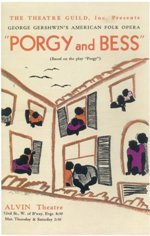
Version 2
Porgy and Bess (1935-10-Neil Simon Theatre-Broadway)
Type de série: OriginalThéâtre: Neil Simon Theatre (Broadway - Etats-Unis)
Durée : 3 mois 2 semaines
Nombre : 124 représentations
Première Preview : jeudi 10 octobre 1935
Première : jeudi 10 octobre 1935
Dernière : samedi 25 janvier 1936
Mise en scène :
Chorégraphie :
Producteur :

Version 4
Porgy and Bess (1942-01-Majestic Theatre-Broadway)
Type de série: RevivalThéâtre: Majestic Theatre (Broadway - Etats-Unis)
Durée : 8 mois 1 semaine
Nombre : 286 représentations
Première Preview : jeudi 22 janvier 1942
Première : jeudi 22 janvier 1942
Dernière : samedi 26 septembre 1942
Mise en scène : Herbert Ross •
Chorégraphie :
Producteur :
Commentaires longs: The noted director and producer Cheryl Crawford produced professional stock theater in Maplewood, New Jersey for three enormously successful seasons, the last of which was meant to close with Porgy and Bess. In re-fashioning it in the style of musical theater which Americans were used to hearing from Gershwin, Crawford produced a drastically cut version of the opera compared with the first Broadway staging. The orchestra was reduced, the cast was halved, and many recitatives were reduced to spoken dialog.[6]
Having seen the performance, theater owner Lee Shubert arranged for Crawford to bring Porgy and Bess back to Broadway. The show opened at the Majestic Theater in January 1942.[7] Duncan and Brown reprised their roles as the title characters, with Alexander Smallens again conducting. In June the brilliant contralto Etta Moten, whom Gershwin had first envisioned as Bess, replaced Brown as Bess. She was such a success that this became her signature role. This production was far more successful financially than the original.

Version 5
Porgy and Bess (1943-03-Royal Danish Theatre-Copenhague)
Type de série: Original EuropeThéâtre: Royal Danish Theatre (Copenhague - Dannemark)
Durée :
Nombre :
Première Preview : samedi 27 mars 1943
Première : samedi 27 mars 1943
Dernière : Inconnu
Mise en scène :
Chorégraphie :
Producteur :
Commentaires longs: On March 27, 1943, the opera had its European premiere at the Royal Danish Theatre in Copenhagen. This performance is notable as it was put on by an all-white cast during Nazi occupation. After 22 sold-out performances, the Nazis closed the production

Version 6
Porgy and Bess (1943-09-44th Street Theatre-Broadway)
Type de série: RevivalThéâtre: 44th Street Theatre (Broadway - Etats-Unis)
Durée : 2 semaines
Nombre : 24 représentations
Première Preview : dimanche 12 septembre 1943
Première : dimanche 12 septembre 1943
Dernière : samedi 02 octobre 1943
Mise en scène : Herbert Ross •
Chorégraphie :
Producteur :
Commentaires longs: The noted director and producer Cheryl Crawford produced professional stock theater in Maplewood, New Jersey for three enormously successful seasons, the last of which was meant to close with Porgy and Bess. In re-fashioning it in the style of musical theater which Americans were used to hearing from Gershwin, Crawford produced a drastically cut version of the opera compared with the first Broadway staging. The orchestra was reduced, the cast was halved, and many recitatives were reduced to spoken dialog.[6]
Having seen the performance, theater owner Lee Shubert arranged for Crawford to bring Porgy and Bess back to Broadway. The show opened at the Majestic Theater in January 1942.[7] Duncan and Brown reprised their roles as the title characters, with Alexander Smallens again conducting. In June the brilliant contralto Etta Moten, whom Gershwin had first envisioned as Bess, replaced Brown as Bess. She was such a success that this became her signature role. This production was far more successful financially than the original.

Version 7
Porgy and Bess (1944-02-City Center-New York)
Type de série: RevivalThéâtre: City Center (New-York - Etats-Unis)
Durée : 2 mois
Nombre : 64 représentations
Première Preview : lundi 07 février 1944
Première : lundi 07 février 1944
Dernière : samedi 08 avril 1944
Mise en scène : Herbert Ross •
Chorégraphie :
Producteur :
Commentaires longs: The noted director and producer Cheryl Crawford produced professional stock theater in Maplewood, New Jersey for three enormously successful seasons, the last of which was meant to close with Porgy and Bess. In re-fashioning it in the style of musical theater which Americans were used to hearing from Gershwin, Crawford produced a drastically cut version of the opera compared with the first Broadway staging. The orchestra was reduced, the cast was halved, and many recitatives were reduced to spoken dialog.[6]
Having seen the performance, theater owner Lee Shubert arranged for Crawford to bring Porgy and Bess back to Broadway. The show opened at the Majestic Theater in January 1942.[7] Duncan and Brown reprised their roles as the title characters, with Alexander Smallens again conducting. In June the brilliant contralto Etta Moten, whom Gershwin had first envisioned as Bess, replaced Brown as Bess. She was such a success that this became her signature role. This production was far more successful financially than the original.

Version 8
Porgy and Bess (1952-10-Peacock Theatre-London)
Type de série: Original LondonThéâtre: Peacock Theatre (Londres - Angleterre)
Durée : 4 mois
Nombre :
Première Preview : jeudi 09 octobre 1952
Première : jeudi 09 octobre 1952
Dernière : mardi 10 février 1953
Mise en scène : Robert Breen •
Chorégraphie :
Producteur :
Commentaires longs: Blevins Davis and Robert Breen produced a revival in 1952 which restored much of the music cut in the Crawford version, including many of the recitatives, and divided the opera into two acts, with the intermission occurring after Crown forces Bess to stay on Kittiwah Island. This version restored the work to a more operatic form, though not all of the recitatives were retained, and Porgy and Bess was warmly received through Europe.[5] The London premiere took place on October 9, 1952 at the Stoll Theatre, where it remained until February 10, 1953.[8]
Notable also was this production's original cast, with Leontyne Price as Bess, William Warfield as Porgy, and Cab Calloway as Sportin' Life, a role that was conceived with him in mind. The small role of Ruby was played by a young Maya Angelou. Price and Warfield met and wed while on the tour.
After a small tour of Europe financed by the United States Department of State, the production came to Broadway's Ziegfeld Theatre. It went on the road again in the fall of 1954 to Latin America, the Middle East and Europe, though Price and Warfield had since left the production.
In this tour Porgy and Bess premiered at La Scala in Milan, in February 1955. A historic yet tense premiere took place in Moscow in December 1955, the first time an American theater group had been to the Soviet capital since the Bolshevik Revolution. Author Truman Capote traveled with the cast and crew, and wrote an account included in his book The Muses Are Heard.

Version 9
Porgy and Bess (1953-03-Ziegfield Theatre-Broadway)
Type de série: RevivalThéâtre: Ziegfield Theatre (Broadway - Etats-Unis)
Durée :
Nombre : 305 représentations
Première Preview : mardi 10 mars 1953
Première : mardi 10 mars 1953
Dernière : mardi 10 mars 1953
Mise en scène : Robert Breen •
Chorégraphie :
Producteur :
Commentaires longs: Blevins Davis and Robert Breen produced a revival in 1952 which restored much of the music cut in the Crawford version, including many of the recitatives, and divided the opera into two acts, with the intermission occurring after Crown forces Bess to stay on Kittiwah Island. This version restored the work to a more operatic form, though not all of the recitatives were retained, and Porgy and Bess was warmly received through Europe.[5] The London premiere took place on October 9, 1952 at the Stoll Theatre, where it remained until February 10, 1953.[8]
Notable also was this production's original cast, with Leontyne Price as Bess, William Warfield as Porgy, and Cab Calloway as Sportin' Life, a role that was conceived with him in mind. The small role of Ruby was played by a young Maya Angelou. Price and Warfield met and wed while on the tour.
After a small tour of Europe financed by the United States Department of State, the production came to Broadway's Ziegfeld Theatre. It went on the road again in the fall of 1954 to Latin America, the Middle East and Europe, though Price and Warfield had since left the production.
In this tour Porgy and Bess premiered at La Scala in Milan, in February 1955. A historic yet tense premiere took place in Moscow in December 1955, the first time an American theater group had been to the Soviet capital since the Bolshevik Revolution. Author Truman Capote traveled with the cast and crew, and wrote an account included in his book The Muses Are Heard.

Version 14
Porgy and Bess (1976-09-Broadway Run)
Type de série: RevivalThéâtre: Broadway Run (Broadway - Etats-Unis)
Durée : 3 mois 2 semaines
Nombre : 7 previews - 122 représentations
Première Preview : lundi 20 septembre 1976
Première : samedi 25 septembre 1976
Dernière : dimanche 09 janvier 1977
Mise en scène : Jack O'Brien •
Chorégraphie :
Producteur :
Commentaires longs: The Houston Grand Opera production which opened on September 25, 1976 helped to turn the tide. For the first time, an American opera company, not a Broadway production company, had tackled the opera. This production was based on Gershwin's original full score and did not incorporate the cuts and other changes which Gershwin had made before the New York premiere. It allowed the public to take in the operatic whole as first envisioned by the composer. In this light, it became clear that Porgy and Bess was indeed an opera. Donnie Ray Albert, Clamma Dale and Larry Marshall starred, respectively, as Porgy, Bess and Sportin' Life. This production won the Houston Grand Opera a Tony Award—the only opera ever to receive one—and a Grammy Award.

Version 15
Porgy and Bess (1976-09-Broadway Run-Mark Hellinger Theatre-Broadway))
Type de série: RevivalThéâtre: Mark Hellinger Theatre (Broadway - Etats-Unis)
Durée : 1 mois
Nombre :
Première Preview : mardi 07 décembre 1976
Première : mardi 07 décembre 1976
Dernière : dimanche 09 janvier 1977
Mise en scène : Jack O'Brien •
Chorégraphie :
Producteur :
Commentaires longs: The Houston Grand Opera production which opened on September 25, 1976 helped to turn the tide. For the first time, an American opera company, not a Broadway production company, had tackled the opera. This production was based on Gershwin's original full score and did not incorporate the cuts and other changes which Gershwin had made before the New York premiere. It allowed the public to take in the operatic whole as first envisioned by the composer. In this light, it became clear that Porgy and Bess was indeed an opera. Donnie Ray Albert, Clamma Dale and Larry Marshall starred, respectively, as Porgy, Bess and Sportin' Life. This production won the Houston Grand Opera a Tony Award—the only opera ever to receive one—and a Grammy Award.

Version 16
Porgy and Bess (1976-09-Broadway Run-Uris Theatre-Broadway Theatre)
Type de série: RevivalThéâtre: Gershwin Theatre (Broadway - Etats-Unis)
Durée : 2 mois 1 semaine
Nombre :
Première Preview : lundi 20 septembre 1976
Première : samedi 25 septembre 1976
Dernière : dimanche 05 décembre 1976
Mise en scène : Jack O'Brien •
Chorégraphie :
Producteur :
Commentaires longs: The Houston Grand Opera production which opened on September 25, 1976 helped to turn the tide. For the first time, an American opera company, not a Broadway production company, had tackled the opera. This production was based on Gershwin's original full score and did not incorporate the cuts and other changes which Gershwin had made before the New York premiere. It allowed the public to take in the operatic whole as first envisioned by the composer. In this light, it became clear that Porgy and Bess was indeed an opera. Donnie Ray Albert, Clamma Dale and Larry Marshall starred, respectively, as Porgy, Bess and Sportin' Life. This production won the Houston Grand Opera a Tony Award—the only opera ever to receive one—and a Grammy Award.

Version 17
Porgy and Bess (1983-03-Radio City Music Hall-New York)
Type de série: RevivalThéâtre: Radio City Music Hall (New-York - Etats-Unis)
Durée : 1 mois 1 semaine
Nombre : 45 représentations
Première Preview : samedi 19 mars 1983
Première : jeudi 07 avril 1983
Dernière : dimanche 15 mai 1983
Mise en scène : Jack O'Brien •
Chorégraphie :
Producteur :

Version 18
Porgy and Bess (1985-02-Metropolitan Opera-New York)
Type de série: RevivalThéâtre: Lincoln Center for the Performing Arts (New-York - Etats-Unis)
Durée :
Nombre :
Première Preview : mercredi 06 février 1985
Première : mercredi 06 février 1985
Dernière : Inconnu
Mise en scène : Nathaniel Merrill •
Chorégraphie :
Producteur :
Commentaires longs: After toying since the 1930s with the idea of staging the opera, the Metropolitan Opera finally did so in 1985, opening on February 6, with a brilliant cast, including Simon Estes, Grace Bumbry, Bruce Hubbard, Gregg Baker and Florence Quivar. The Met production was directed by Nathaniel Merrill and designed by Robert O'Hearn. The conductor was James Levine.[10]

Version 19
Porgy and Bess (1986-07-Glyndebourne Festival-Glyndebourne)
Type de série: RevivalThéâtre: Glyndebourne Festival (Glyndebourne - Angleterre)
Durée :
Nombre :
Première Preview : Inconnu
Première : Inconnu
Dernière : Inconnu
Mise en scène : Trevor Nunn •
Chorégraphie :
Producteur :
Commentaires longs: Trevor Nunn tackled the work in an acclaimed 1986 production at England's Glyndebourne Festival. The 1986 Trevor Nunn production was scenically expanded and videotaped for television in 1993 (see below in "Film and television"). These productions were also based on the "complete score," without incorporating Gershwin's revisions. A semi-staged version of this production was performed at the Proms in 1998.

Version 21
Porgy and Bess (2000-03-New York City Opera-New York)
Type de série: RevivalThéâtre: New York City Opera (New-York - Etats-Unis)
Durée : 2 semaines
Nombre : 10 représentations
Première Preview : mardi 07 mars 2000
Première : mardi 07 mars 2000
Dernière : samedi 25 mars 2000
Mise en scène : Tazewell Thompson •
Chorégraphie :
Producteur :
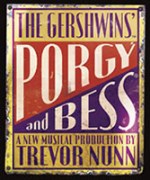
Version 22
Porgy and Bess (2006-10-Savoy Theatre-London)
Type de série: RevivalThéâtre: Savoy Theatre (Londres - Angleterre)
Durée : 5 mois 3 semaines
Nombre :
Première Preview : mercredi 25 octobre 2006
Première : jeudi 09 novembre 2006
Dernière : samedi 05 mai 2007
Mise en scène : Trevor Nunn •
Chorégraphie : Jason Pennycooke •
Producteur :
Avec : Cast: Clarke Peters (Porgy), Nicola Hughes (Bess), O-T Fagbenie (Sportin’Life), Cornell S John (Crown), Edward Baruwa, Yolanda Grant-Thompson, Ruby King, Lorraine Velez, Des Coleman, Anton Stephans
Commentaires : Notes: Trevor Nunn had directed the opera “Porgy and Bess” at Glyndebourne in 1986, and that production, conducted by Simon Rattle, was re-created as a television opera in 1993, and re-staged for a one-night concert version at the 1998 Royal Albert Hall Promenade Season. This, however, was produced as a “musical” not an opera. Working with the Gershwin estate, Nunn used dialogue from the original novel and subsequent Broadway stage play to replace the recitatives with naturalistic scenes. He also considerably reduced its running time. He did not cast operatic voices but relied on musical theatre actors as leads. Gareth Valentine re-scored the work for a 20-strong orchestra (as opposed to the 50 piece symphony orchestra of the Glyndebourne version).
In spite of generally welcoming reviews the show did not attract an audience, and closed after just a few months.
Presse : NICHOLAS DE JONGH for THE EVENING STANDARD says, " Ardent production." PAUL TAYLOR for THE INDEPENDENT says, " 'Electrifying' is an overworked word in the critical lexicon, but if ever a show deserved it, it is Trevor Nunn's magnificent revival of the Gershwins' Porgy and Bess." SCOTT MATTHEWMAN for THE STAGE says, "A visual and aural spectacle." MICHAEL BILLINGTON for THE GUARDIAN says, "If the show now seems a museum-piece, Nunn's production invests it with social detail...this is an essentially conservative show." BENEDICT NIGHTINGALE for THE TIMES says, "Nunn’s company brings enormous energy and plenty of class to Ira Gershwin’s libretto."
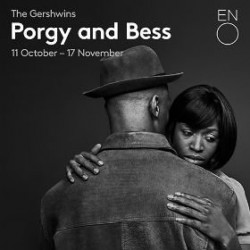
Version 23
Porgy and Bess (2018-10-Coliseum Theatre-London)
Type de série: RevivalThéâtre: Coliseum Theatre (Londres - Angleterre)
Durée : 1 mois 1 semaine
Nombre :
Première Preview : jeudi 11 octobre 2018
Première : jeudi 11 octobre 2018
Dernière : samedi 17 novembre 2018
Mise en scène : James Robinson •
Chorégraphie : Dianne McIntyre •
Producteur :
Avec : Eric Greene (Porgy), Nicole Cabell (Bess), Nmon Ford (Crown), Latonia Moore (Serena), Gweneth-Ann Rand (Serena) - Oct 27/31/Nov 10), Nadine Benjamin (Clara), Tichina Vaughn (Maria), Donovan Singletary (Jake), Frederick Ballentine (Sporting Life), Rheinaldt Tshepo Moagi (Mingo), Chaz'men Williams-Ali (Robbins/Crab Man), Byron Jackson (Frazier), Sarah-Jane Lewis (Annie), Nozuko Teto (Strawberry Woman), Njabulo Madlala (Jim), Whitaker Mills (Undertaker), Thando Mjandana (Nelson).
Commentaires : More than 80 years after its premiere, Porgy and Bess receives its first ENO staging. Written for a large cast, with a 40-voice chorus specially formed for this production, and full orchestra, Porgy and Bess is infused with unforgettable melodies, including the much-loved ‘Summertime’. This is a stage work that is emotionally charged, powerful and moving, delivered through jazz, ragtime, blues and spirituals.
Presse : “Thrilling... spine-tingling” The Times
“Electrifying... does Gershwin proud" The Independent
"This is how to do it" The Guardian
“Should not be missed” The Arts Desk
Pas encore de video disponible pour ce spectacle

.png)
.png)





